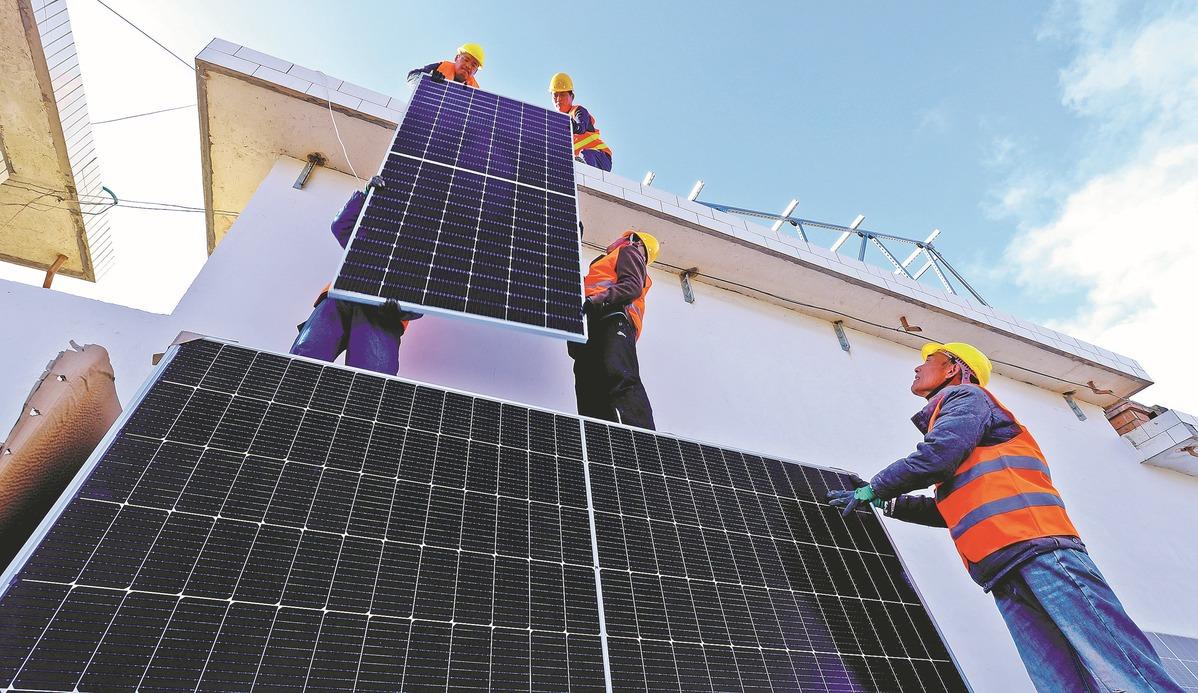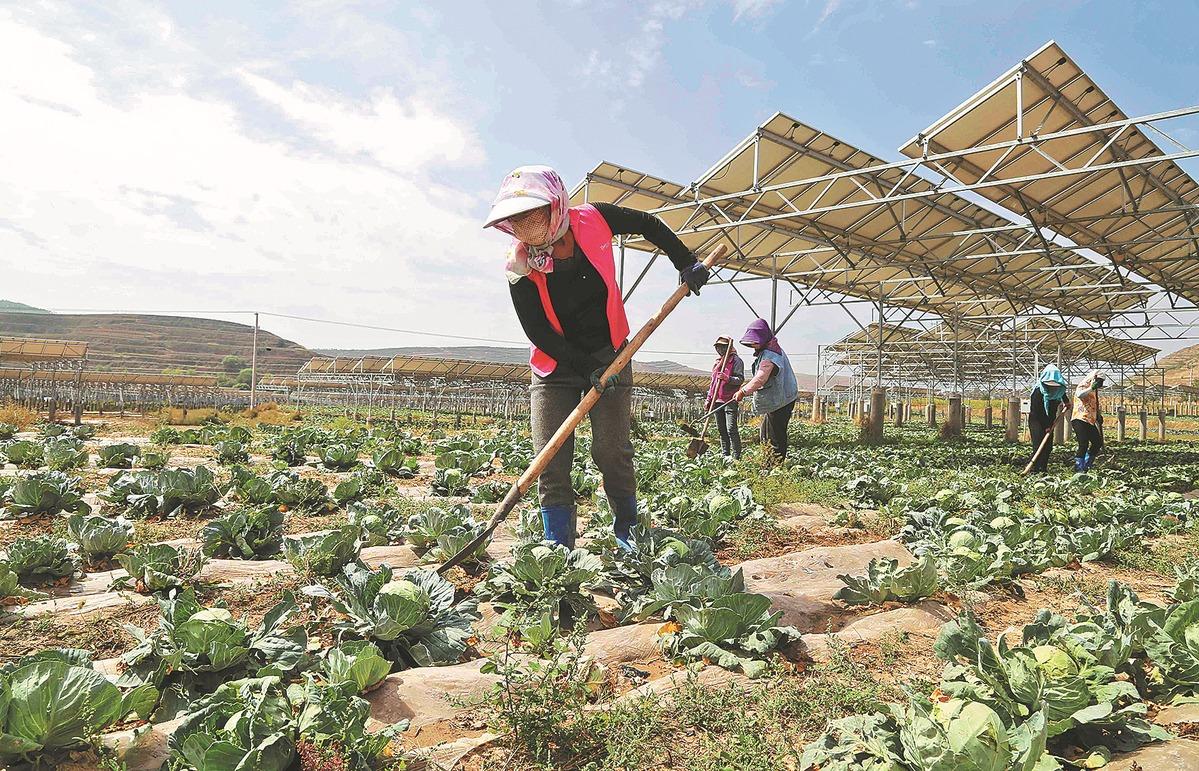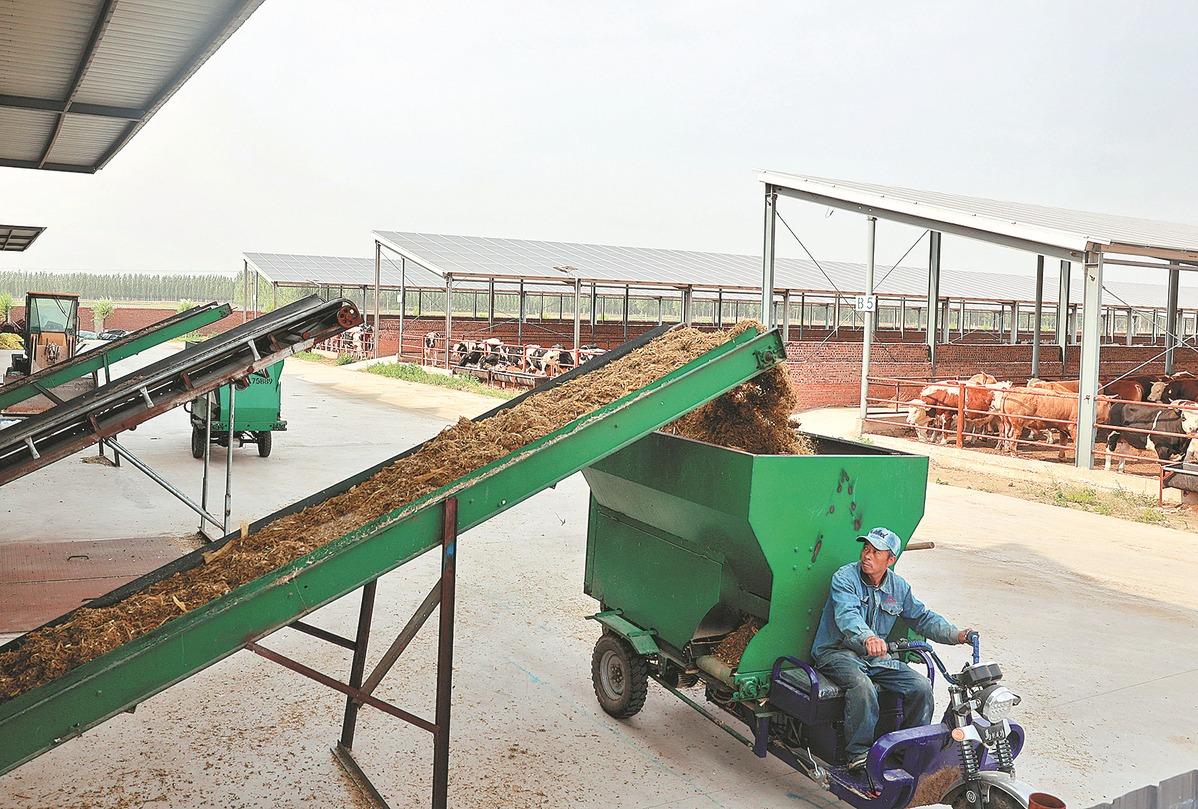Policies needed to cover regulatory gap, improve maintenance to ensure safe operation, sustainability, deputy says
 Police officers and electricians inspect a lake-based photovoltaic power station in Baoying county, Jiangsu province, in June 2023. (SHEN DONGBING / FOR CHINA DAILY)
Police officers and electricians inspect a lake-based photovoltaic power station in Baoying county, Jiangsu province, in June 2023. (SHEN DONGBING / FOR CHINA DAILY)
Solar energy will be a game-changer in China's rural regions, offering a reliable and affordable answer to local energy demands while facilitating the green energy transition nationwide, according to national legislators, political advisers and industry experts.
Solar energy, with no fuel costs and low maintenance costs, has been developing rapidly in China's rural regions over the past few years, and has created savings in rural communities by replacing expensive and inefficient traditional fuels, said Zhong Baoshen, chairman of Longi Green Energy Technology Co.
READ MORE: PV firms eye offshore energy potential
It has the potential to revolutionize the energy landscape in China's rural regions, enabling millions of people to access clean and sustainable power, and be the driver toward a net-zero world, said Zhong, who is also a deputy to the 14th National People's Congress.
Zhong Baoshen called for comprehensive policies at the national level to address the current regulatory gaps and ensure the long-term sustainability and reliability of the rural photovoltaic sector
However, despite its rapid expansion, the sector is marred by various irregularities, including inconsistent component quality and inadequate corrosion prevention measures in crucial elements, as well as a lack of proper infrastructure such as grid connectivity and transmission lines to distribute solar energy effectively, he said.
The varying quality of photovoltaic components, coupled with a lack of maintenance and management of solar products in rural regions, pose risks to the overall construction quality of solar power stations in rural areas, leading to operational challenges and potential safety hazards, said Zhong.
ALSO READ: State energy firms turn to renewables abroad
He called for comprehensive policies at the national level to address the current regulatory gaps and ensure the long-term sustainability and reliability of the rural photovoltaic sector.
The absence of a dedicated operational and maintenance framework tailored specifically for rural photovoltaic installations makes it difficult to make better use of solar power, and it is urgent for the country to formulate comprehensive policies that address this gap, ensuring the development of high-quality standards for the construction and implementation of rural photovoltaic projects, he said.
 Workers install PV panels on residents' roofs in Xijie village in Zhangye, Gansu province, in November 2023. (WANG JIANG / FOR CHINA DAILY)
Workers install PV panels on residents' roofs in Xijie village in Zhangye, Gansu province, in November 2023. (WANG JIANG / FOR CHINA DAILY)
According to a guideline underpinning green development in urban and rural areas released by the State Council, by 2035 green development will cover urban and rural areas in a comprehensive way, with an increased cut in carbon emissions.
China's rural areas, encompassing over 90 percent of the nation's total land area, hold immense potential for the development of rural photovoltaics. In the new era, photovoltaics will not only empower the vitalization of rural industries and contribute to shared prosperity, but also provide a robust driving force for green, low-carbon development and the construction of beautiful rural landscapes, said Zhong.
According to the National Energy Administration, the growth of distributed solar power's installed capacity surpassed that of utility solar power for the first time in 2021, making up about 55 percent of China's total newly increased solar power installed capacity
Figures released by the renewable energy center of the National Development and Reform Commission's energy research institute show that China's newly added distributed photovoltaic capacity reached 96.29 gigawatts last year, marking an 88 percent year-on-year growth. The cumulative installed capacity of distributed photovoltaics stands at 253 gigawatts so far, constituting 42 percent of the total installed capacity of photovoltaics in the country, it said.
READ MORE: China's solar sector readying for new challenges
Distributed solar power and utility solar power are two major types of solar power in China. The former refers to an approach to installing solar power facilities and generating power at or near where it will be used, such as on rooftops, and has become a major force driving installed capacity growth. It also has fewer requirements on land and cost, compared with utility solar power, which is usually deployed in massive land areas such as deserts.
As a result, numerous photovoltaic enterprises, including Longi, JA Solar Technology, Jinko Solar Co and Sungrow Power Supply Co, are launching residential photovoltaic products, while State-owned enterprises and local government enterprises, which have traditionally been enthusiastic investors in centralized photovoltaic power stations, have also joined in.
Longi said it has been teaming up with numerous State-owned enterprises, including China Energy Investment Corp and State Power Investment Corp, to jointly tap residential photovoltaic products and expand their rural use.
ALSO READ: China's installed power generation capacity jumps 13.6%
According to the National Energy Administration, the growth of distributed solar power's installed capacity surpassed that of utility solar power for the first time in 2021, making up about 55 percent of China's total newly increased solar power installed capacity. This trend means that distributed solar power, especially for family use, has become an important source in China's efforts to peak carbon dioxide emissions before 2030 and achieve carbon neutrality before 2060.
 Farmers plant cabbages near PV panels in Tongwei, Gansu province, in September 2023. (PHOTO / XINHUA)
Farmers plant cabbages near PV panels in Tongwei, Gansu province, in September 2023. (PHOTO / XINHUA)
In addition to reducing fees for self-consumed renewable energy and encouraging high-scale utilization of new energy sources, Zhong also suggested expanding the deployment of building-integrated photovoltaics, or BIPV, one of the two main types of rooftop solar power in addition to building-attached photovoltaics.
China's surge in rooftop solar power installations has driven up the world's total rooftop solar capacity. According to the China BIPV Association, BIPV, which takes up a major part of China's rooftop solar power market, will have a market size valued at up to 40 billion yuan ($5.55 billion) in 2025.
ALSO READ: Country aims to shine in space-based solar power tech to boost clean energy
China plans to cover as many as half of its new buildings that are classified as public institutions with rooftop solar panels by 2025, according to a statement jointly released by the NDRC and the NEA, which also noted that China will actively promote rooftop solar power installation in rural areas and industrial parks.
"Compared with cities, China's rural areas have more spare spaces to install solar power systems at lower costs," said Lin Boqiang, head of the China Institute for Studies in Energy Policy at Xiamen University.
"As developing distributed solar power in rural areas also offers residents extra earnings and helps reduce power expenses, local governments and power supply companies should continue to simplify processes to better tap the potential in distributed photovoltaics in China's rural regions as long as it is legal, compliant and beneficial to the industry."
 Workers prepare feed for cattle at a farm in Tangshan, Hebei province, in May 2023. (PHOTO / XINHUA)
Workers prepare feed for cattle at a farm in Tangshan, Hebei province, in May 2023. (PHOTO / XINHUA)
Zhang Xiaobin, executive vice-president of the Shandong Solar Energy Industry Association, believes the southern markets will continue to remain robust, including those in Jiangxi and Fujian provinces and the Guangxi Zhuang autonomous region.
Wang Dongsheng, chairman of the Hong Kong and Shanghai Banking Corporation who is also a political adviser this year, agreed, saying that joint efforts are required to promote the development of distributed photovoltaics in the Guangdong-Hong Kong-Macao Greater Bay Area.
The GBA market is one of the most dynamic and internationally advanced regions in the Chinese economy, serving as a new engine for sustainable and high-quality development with massive potential for distributed solar power development and energy optimization, he said.
READ MORE: China's installed solar, wind power capacity surges
Research conducted by HSBC on the development of distributed photovoltaics in the GBA indicates that despite great potential, there are still various challenges in terms of investment and financing, he said.
Wang suggested enhancing government coordination and planning, innovating business models and introducing innovative green financial products to accelerate the development of distributed photovoltaics in the GBA.


